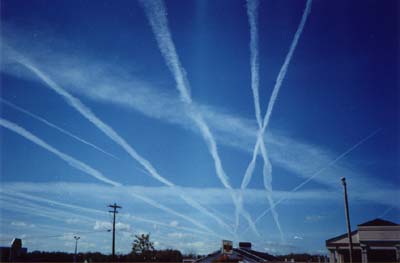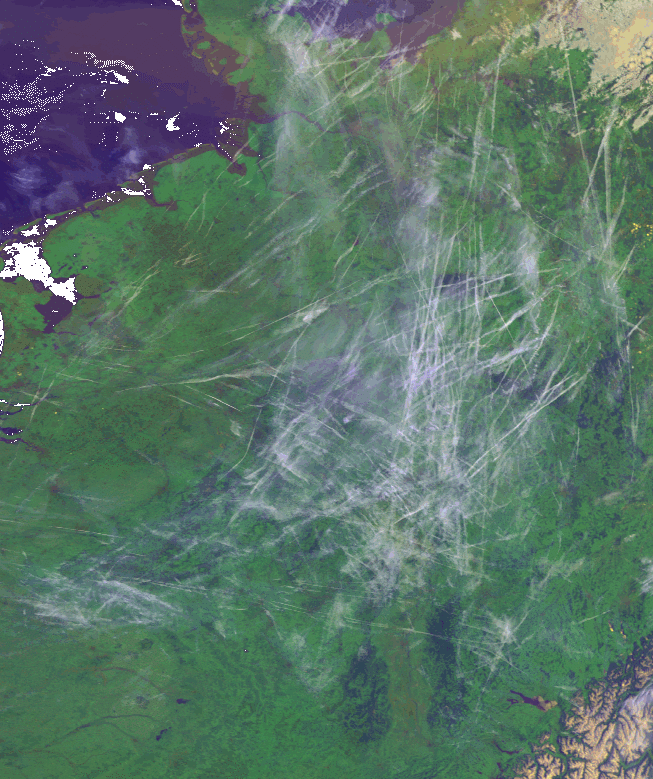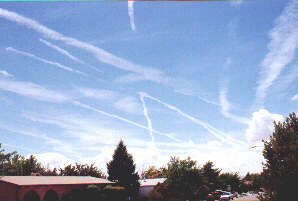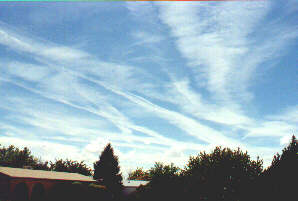
What is a contrail and how does it form?
To answer this question, lets first identify what a contrail is. A contrail is the condensation trail
that is left behind by a passing jet plane. Contrails form when hot humid air from jet exhaust mixes with
environmental air of low vapor pressure and low temperature. Vapor pressure is just a fancy term for the
amount of pressure that is exerted by water vapor itself (as opposed to atmospheric, or barometric, pressure which is
due to the weight of the entire atmosphere above you). The mixing occurs directly behind the plane due to the
turbulence generated by the engine. If condensation (conversion from a gas to a liquid) occurs, then a contrail
becomes visible. Since air temperatures at these high atmospheric levels are very cold (generally colder than -40 F),
only a small amount of liquid is necessary for condensation to occur. Water is a normal byproduct of combustion
in engines.
This cloud formation is very similar to the process that occurs when you breath on a cold winter
day and you can see your own breath in the form of a "cloud". You may have noticed that on some days this "cloud" you
produce lasts longer than on other days where it quickly disappears. The length of time that a contrail lasts is
directly proportional to the amount of humidity that is already in the atmosphere. A drier atmosphere leads to
a more short-lived contrail, while an atmosphere that has more humidity will lead to longer-lived contrails. However, if
the atmosphere is too dry, no contrails will form. Occasionally a jet plane, especially if ascending or descending,
will pass through a much drier or more moist layer of atmosphere which may result in a broken pattern to the
contrail, with it appearing in segments rather than in one continuous plume.

Contrails can be found over most of the planet. Now that jet plane traffic, both civilian and military,
can be at anyplace over the globe at anytime, contrails are becoming more and more common. This picture was taken
by the NOAA-12 satellite as it passed over portions of Europe in 1995. It is very
obvious from this color enhanced satellite image that the atmosphere was very conducive to the development
of contrails on this date (5 April 1995) and that these contrails were long-lived enough to accumulate with many
criss-cross patterns over the same heavily travelled portion of air space.
Contrails have been recorded throughout the history of jet plane travel. Many reports exist from World War II of
situations where the accumulations of contrails was so extensive that pilots were unable to keep visual contact
with neighbor or enemy planes during combat. Contrails have been recorded from the Sahara Desert to the South Pole
indicating that contrails are not constrained to only populated regions of the Earth.
If contrails persist for a long enough period of time, say on the order of an hour or more, they can spread out
across the sky due to the prevailing winds at the level at which they formed. The two figures below show how contrails
generated on this particular day spread out fairly quickly due to the stronger jet stream of air aloft. Persistence
of contrails is neither an indication that they contain some kind of chemical, nor that it is some kind of spray. As
a matter of fact, sailors have known for some time to look specifically at the patterns and persistence of jet
contrails for weather forecasting. On days where the contrails disappear quickly or don't even form,
they can expect continuing good weather, while on days where they persist, a change in the weather pattern may
be expected.


Contrails are a concern in climate studies as increased jet traffic may result in an increase in cloud cover. Several
scientific studies are being conducted with respect to contrail formation and their climatic effects. Cirrus clouds
affect Earth's climate by reflecting incoming sunlight and inhibiting heat loss from the surface of the planet. It has been
estimated that in certain heavy air-traffic corridors, cloud cover has increased by as much as 20%. Since contrails
can spread out and essentially become cirrus clouds, it is felt that contrails may affect the planetary climate in
similar ways. Other studies are underway to better understand the role that jet exhaust itself plays in modifying the
chemistry of the upper levels of the atmosphere.
How can I find out more about contrails?
There is a lot of information on the internet regarding contrails and some of the studies that are ongoing
relating to research attempts at better understanding contrails. Those links provided below are only
a few of the locations elsewhere on the web where you can find more information regarding contrails.
|


